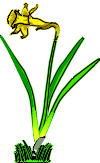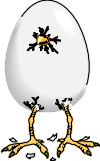 It's the time of year when new buds start to appear on the trees,
blossoms emerge from their winter nap, and all creatures are pairing off. You've been
reading up on it, and now everyone is getting prepared... are you? It's breeding season!
It's the time of year when new buds start to appear on the trees,
blossoms emerge from their winter nap, and all creatures are pairing off. You've been
reading up on it, and now everyone is getting prepared... are you? It's breeding season!  It's the time of year when new buds start to appear on the trees,
blossoms emerge from their winter nap, and all creatures are pairing off. You've been
reading up on it, and now everyone is getting prepared... are you? It's breeding season!
It's the time of year when new buds start to appear on the trees,
blossoms emerge from their winter nap, and all creatures are pairing off. You've been
reading up on it, and now everyone is getting prepared... are you? It's breeding season!
Breeding birds in captivity is no longer the mystical and iffy experience it was in the past. Time has taught us much about what caged birds need to stimulate captive breeding. Today, many are successfully bred by their owners. For the most part, our pets have a natural imprint of what to do - if we would just let them.
 While nature does provide, taking the birds from their natural
environment gives them some handicaps. Some mom's and dad's can't totally forget they are
domesticated pets, and may at some point neglect their babies. In these cases, we need to
be prepared to step in and give a helping hand. If you have never been through it, you
should certainly read up on breeding and hand-rearing. Also, if you know someone who has
successfully bred their birds, ask them to give you some pointers (if they are really
nice, they'll let you call them at 3AM when that emergency comes up).
While nature does provide, taking the birds from their natural
environment gives them some handicaps. Some mom's and dad's can't totally forget they are
domesticated pets, and may at some point neglect their babies. In these cases, we need to
be prepared to step in and give a helping hand. If you have never been through it, you
should certainly read up on breeding and hand-rearing. Also, if you know someone who has
successfully bred their birds, ask them to give you some pointers (if they are really
nice, they'll let you call them at 3AM when that emergency comes up).
Here are some of the highlights on the breeding process. It is by no means complete. Before you decide to try your hand at it, make sure you have read a good book, talked extensively with an experienced breeder, and stocked up on coffee (for those around the clock feedings you are in for). It's a rewarding experience, but you should be very well prepared.
What's Your Sign?
For the majority of parrots, the addition of a nesting box and extended daylight trigger those feelings deep down. There are some dietary supplements that will help those who can't find that loving feeling (like hemp and wheat-germ). Extra vitamin-rich foods, and a source of calcium (necessary for egg production) are also important. Your pets will take on what may seem to be odd behavior - but that's part of the process. Be sure to take notes on what you see. This will help you next year, and will also be important if you need to relay details to someone for help.
Nature Calls
If nature has taken its course, you have seen some very impressive acrobatics (and had some great stories to relay to friends). While the hen is preparing to pop out the soon-to-be bundles of joys, she'll be consuming mass quantities of food (particularly soft, prepared foods). Her mate will be redecorating the nest box by gnawing at the entry hole, and gathering materials to line the bottom. He should be very possessive over his work (to put it lightly), so distance may be advisable. Don't worry, they will be your pets again, in a few months.
Take your cue here to make sure you have things in order. You don't need to practice your breathing, or pack a bag for the hospital. You do need to make sure you are prepared to take over if you have less than enthusiastic parents. You need a brooder of sorts to control the temperature and humidity, hand feeding syringes, formula, and measuring equipment (scale, Pyrex measuring cups, and thermometers), and bands to go on the chicks legs (you did order them at least 6 to 8 weeks ago, didn't you?).
A brooder can be a 10-gallon aquarium lined with
moistened pine shavings and paper towels. A heating pad under half the tank with an
adjustable thermostat will work. Also, a thermometer at chick level is necessary to ensure
you maintain a healthy environment.
Egg-citing Developments
Once your hen starts laying, it can take several days for all the eggs to appear (depending upon the species of bird). Keep the nesting box moistened and bowls of water in the cage. If the birds are not wetting themselves, you can help them out with a spray bottle. the extra moisture on their chest feathers will help keep the eggs from drying out.
As the eggs appear, and as Daddy allows, mark each with a
non-toxic marker. Record the date each egg was laid, and do so on each end of each egg
(they will break in two later). Since the eggs are laid over several days time, they will
most likely hatch that way, too. Don't be too alarmed if the hatch takes place a little
earlier or later than expected. Some biological clocks run a bit slow (or fast, as the
case may be).
A Face Only A Mother Could Love
It will be hard to believe that the alien-like creature that has just emerged from that cute little pod could ever grow up to be a beautiful and colorful parrot. Thank goodness they grow feathers quickly! Keep your eye on the hen as the feathers come in. She may begin plucking her chicks to force them out of the nest so she can begin breeding again - not a good thing for the chicks or her. In this case, pull the chicks to the brooder and remove the nest box. You may need to pull the male if his actions towards the hen or the chicks is overly aggressive.
Depending on the age and maturity of the parents, be prepared for not all the chicks to hatch or survive. Generally, the younger the parents (and the more inexperienced they are), the higher the mortality rate. It is a hard thing to accept that a fact of life is death, but it can and frequently does happen to a percentage of chicks. Prepare yourself for this as best you can.
Emptying The Nest
At some point, you will need to pull the chicks and begin hand feeding. Hand fed babies are more easily bonded with humans (a good thing for pets). Hand feeding formulas are available in powders, and there are recipes that you can make up yourself. You need to know what you are doing when using a syringe to feed. The water content of the formula is very important and changes with the chicks' development. Temperature is also a critical factor - too hot can cause fatal crop burns. If you aren't careful, the chick could aspirate if formula gets into their lungs. Make sure you get lessons from someone very familiar before you attempt it.
It is important to chart the growth of the chicks. Daily weights should be taken and recorded. Also, you should be measuring the volume of food given. Check the weight charts for your species of bird to ensure they are developing properly, and keep a vet informed of any signs out of the ordinary.
Fly Me To The Food
Your babies are growing up. Hopefully you have left their wings intact to allow them to learn to fly. This is important later - behaviorists believe that having them learn to fly before clipping makes for a more self-assured pet, and also reduces broken feathers caused from a life of un-graceful takeoffs and landings.
Abundance weaning is also an important consideration. Abundance weaning means to keep chicks on formula until they wean themselves. The general thought on this is that the bird again is more self confident, has less poor eating habits, and is more trusting of humans.
And They All Lived Happily Everafter
Your chicks are grown into feathered creatures that now (sort of) resemble their parents, and not some Hollywood-crafted monster (take a look around week 9 here). The urge to keep all these little guys is tempting (or maybe not if the brooder is too close to the bedroom). More than likely you are finding homes for them. When finding new parents, it's important to ensure that your care and love for them is carried onward for the rest of their lives. You are in part responsible for new life on this planet. That is a very solemn privilege. Do these creatures well by making sure their new owners have or will get the proper knowledge to care and provide for the bird. It's not out of the question to make them take an ownership test, and they should be a part of the hand rearing phase (um, maybe not at 3AM, but certainly during part of the day).
We hope this has given you something to think about as nature starts to call out to our feathered kids. Hopefully, it will make you ask yourself if you are up to the challenge and the responsibility that breeding entails. If not ready now, it won't be long until they're ready again (some are ready all the time!). Until then, read all you can, and enjoy the little lives you already have (not to mention all the good rest you've had that the others missed out on).